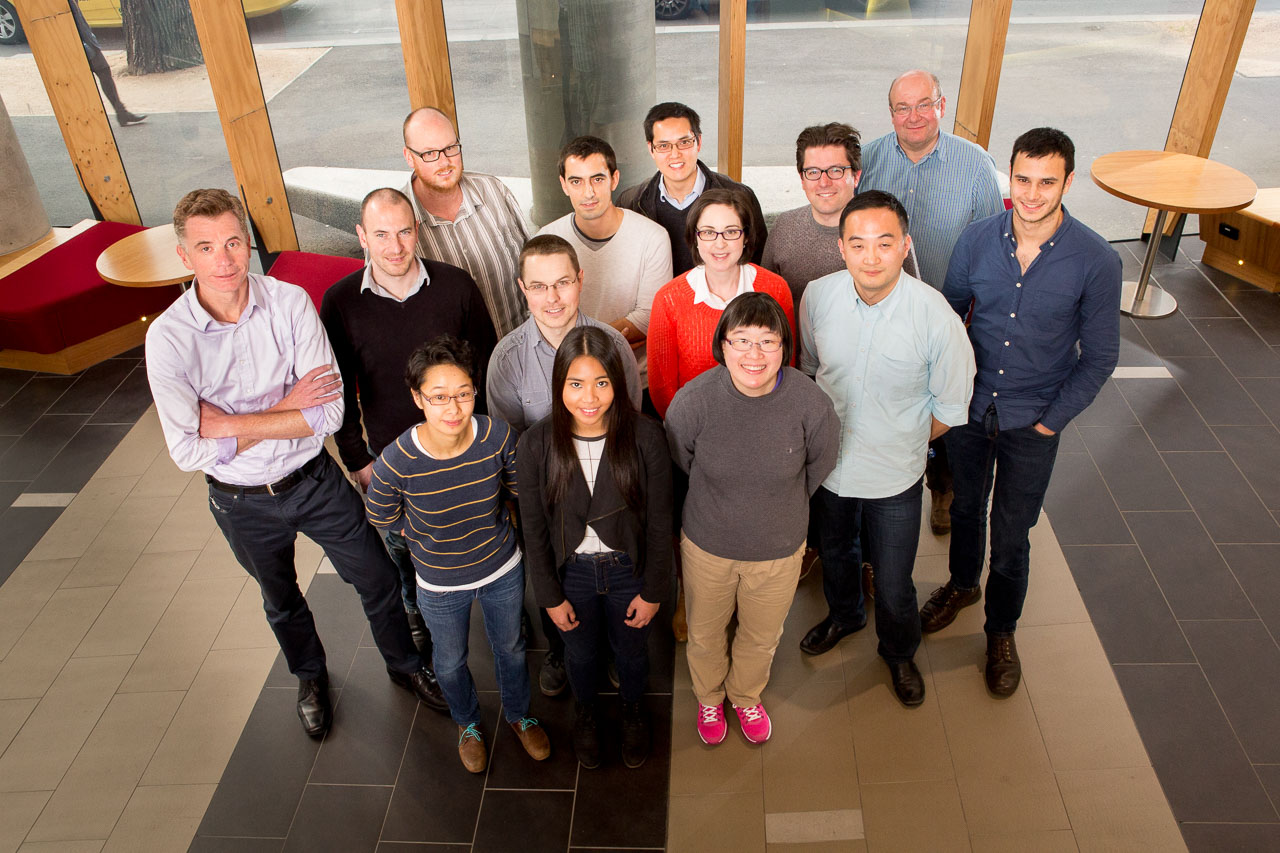-
Research Groups
-
Stinear Group
Tim Stinear’s group’s research addresses priorities across four connected themes that including hospital superbugs, pathogenic mycobacteria, natural product discovery and public health genomics that aim to understand and contain the spread of bacteria causing serious human disease.
Current Projects
-
Hospital superbugs
Staphylococcus aureus and Enterococcus faecium are two major opportunistic human pathogens. Staphylococcus aureus causes a wide range of hospital and community-acquired infections. The mortality rate for serious Staphylococcus aureus infection, particularly methicillin resistant Staphylococcus aureus (MRSA) is high (20–30% of bacteraemia), and the social and financial burden of Staphylococcus aureus-related disease in Australia and worldwide is becoming increasingly significant. Enterococci are members of the gastrointestinal microbiota but they have also emerged as a major cause of healthcare associated infections, accounting for approximately 10% of human cases of bacteraemia. Enterococcus faecium (Efm) and Enterococcus faecalis are the two enterococci that most frequently cause human infections, with resistance to the last-line antibiotic vancomycin becoming common in Enterococcus faecium (VREfm) in the past two decades. Tim’s group is investigating the molecular basis for increasing resistance to antibiotics and also the cleaning agents commonly used to disinfect health care facilities.
-
Mycobacterial pathogens
Tuberculosis (TB) and Buruli ulcer (BU) are distinct but serious diseases caused by infection with Mycobacterium tuberculosis and Mycobacterium ulcerans respectively. TB causes hundreds of thousands of deaths each year and millions of people are infected worldwide. The emergence of multi-drug resistant strains is a major concern. Tim’s group is using the power of genomics to better understand how Mycobacterium tuberculosis causes disease and to use that information to help develop an effective vaccine. BU is a neglected disease and each year, 5000 to 6000 cases are reported from 33 countries across the globe, predominantly from rural regions in West and Central Africa. The disease involves subcutaneous tissue and has several manifestations but necrotic skin ulcers are a common presentation, caused by the proliferation of bacteria beneath the dermis and a secreted bioactive bacterial lipid toxin called mycolactone. Employing genomics, Tim’s group has been at the forefront of describing the biosynthesis and role of mycolactone but the role of this molecule in the natural ecology of Mycobacterium ulcerans is not understood. Epidemiological studies frequently link BU occurrence with low-lying and wetland areas, and human-to-human transmission is rare, suggesting an environmental source of the mycobacterium. Despite more than 70 years of research, the environmental reservoir(s) and mode(s) of transmission of Mycobacterium ulcerans remain unknown. Tim’s group’s research aims to address these key questions.
Tim is leading a major project in collaboration with the Department of Health and Human Services, Barwon Health, Austin Health, CSIRO, Agriculture Victoria, the University of Melbourne and Mornington Peninsula Shire to understand how Buruli ulcer is spread and to indentify effective ways to intervene and reduce infections. For more information, visit the Beating Buruli in Victoria website. -
Public health and clinical microbial genomics
Together with Professor Ben Howden, Tim has created the Doherty Applied Microbial Genomics centre – a research centre focused on establishing microbial genomics as a tool for clinical and public health microbiology in Australia. The sequencing capacity and bioinformatics expertise across the Ben and Tim’s research groups makes them uniquely placed to perform and facilitate applied microbial genomics research.
Lab Team

-
Laboratory Head and Director of the WHO Collaborating Centre for Mycobacterium ulcerans
-
Postdoctoral Researcher
-
Senior Researcher
-
Jessica PorterResearch Assistant
-
Kirstie MangasPhD Student
-
Andrew BuultjensPhD Student
-
Andre MuResearch Officer
-
Centre for Antibiotic Allergy and Research
The Centre for Antibiotic Allergy and Research focuses on translational drug allergy diagnostics, health services interventions and antibiotic allergy clinical trials.
Other work areas include:Public Health
-
Howden Group
Research from Professor Ben Howden’s group research uses genomics, molecular biology, epidemiology and clinical studies to address a broad range of issues related to invasive bacterial diseases in humans, especially those caused by staphylococci, enterococci and other antimicrobial-resistant species. Additionally, working closely with scientists in the MDU PHL, they investigate the epidemiology, evolution, and spread of bacterial pathogens of public health significance such as Neisseria gonorrhoea, Listeria monocytogenes, Shigella and Salmonella spp., Legionella spp., and carbapenemase-producing gram-negative bacteria.

Professor Benjamin Howden
Director Of Microbiological Diagnostic Unit (MDU) Public Health Laboratory
-
McVernon Group
Jodie McVernon’s group uses established and emerging biostatistical, epidemiologic and modelling methods to address infectious diseases questions of public health relevance. We bring a suite of collaborators from animal health and ecology to provide a ‘One Health’ perspective on emerging human pathogens.
Other work areas include:COVID-19, Viral Infectious Diseases, Public Health
-
National Centre for Antimicrobial Stewardship
The National Centre for Antimicrobial Stewardship (NCAS) is a health services research program that aims to improve the use of antimicrobials across animal and human health, to influence national policy, and to generate a research workforce across nurses, pharmacists, doctors and veterinarians. NCAS aims to lead and facilitate the embedding of antimicrobial stewardship (AMS) within clinical practice across diverse healthcare settings and among different practitioner groups in Australia. Its research and surveillance programs aim to improve antimicrobial prescribing by understanding prescribing behaviours through qualitative and quantitative methods, monitoring current prescribing patterns across healthcare settings, identifying targets for quality improvement, and developing interventions, new policies and practices.
-
Robins-Browne Group
Research in Roy’s laboratory is partly focused on how E. coli causes diarrhoea, with the aims of identifying better ways to diagnose, treat and prevent these infections. Another theme is the development of new types of antibacterial agents.
Other work areas include:Enteric infections, Immunology
-
Tong Group
Steve’s group conducts clinical trials to optimise the treatment of infections due to methicillin-resistant Staphylococcus aureus and other bacterial pathogens. He also investigates the epidemiology and genomics of streptococcal infections, hepatitis B, influenza, and antimicrobial resistance in Australian Indigenous communities.
Other work areas include:Staphylococcus aureus, Immunology, Viral Infectious Diseases, Bacterial and Parasitic Infections, Public Health
-
VICNISS
The VICNISS Coordinating Centre provides a state-wide, standardised surveillance service for healthcare associated infections (HAIs) and related events. The goal of VICNISS is to monitor and reduce the incidence of HAIs, providing support for health services in Victoria. VICNISS aims to support Victorian health services to carry out international best practice surveillance and analysis, and to lead interventions for quality improvement to improve the health of all Victorians.
VICNISS provides a source of high quality data for regular performance monitoring, and for a valuable resource for the research community. Over the time of VICNISS surveillance, infection rates in key areas of focus have fallen markedly, reducing the significant financial and personal cost of these infections on both individual patients and the health system.
VICNISS collaborates with the National Centre for Antimicrobial Stewardship (NCAS), with a major involvement in aged care NAPS (ac-NAPS). VICNISS is also engaged by DHHS Residential Aged Care Services to carry out monitoring of infection control indicators in Victoria’s public residential aged care services, including participation in ac-NAPS.
-
Globally, it is estimated
that 700,000 people die
from drug-resistant infections each year







